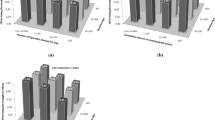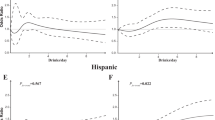Abstract
Objective: There is a common notion that beer drinkers are, on average, more ‘obese’ than either nondrinkers or drinkers of wine or spirits. This is reflected, for example, by the expression ‘beer belly’. However, the few studies on the association between consumption of beer and abdominal obesity produced inconsistent results. We examined the relation between beer intake and waist–hip ratio (WHR) and body mass index (BMI) in a beer-drinking population.
Design: A cross-sectional study.
Setting: General population of six districts of the Czech Republic.
Subjects: A random sample of 1141 men and 1212 women aged 25–64 y (response rate 76%) completed a questionnaire and underwent a short examination in a clinic. Intake of beer, wine and spirits during a typical week, frequency of drinking, and a number of other factors were measured by a questionnaire. The present analyses are based on 891 men and 1098 women who where either nondrinkers or ‘exclusive’ beer drinkers (ie they did not drink any wine or spirits in a typical week).
Results: The mean weekly beer intake was 3.1 l in men and 0.3 l in women. In men, beer intake was positively related to WHR in age-adjusted analyses, but the association was attenuated and became nonsignificant after controlling for other risk factors. There appeared to be an interaction with smoking: the relation between beer intake and WHR was seen only among nonsmokers. Beer intake was not related to BMI in men. In women, beer intake was not related to WHR, but there was a weak inverse association with BMI.
Conclusions: It is unlikely that beer intake is associated with a largely increased WHR or BMI.
This is a preview of subscription content, access via your institution
Access options
Subscribe to this journal
Receive 12 print issues and online access
$259.00 per year
only $21.58 per issue
Buy this article
- Purchase on Springer Link
- Instant access to full article PDF
Prices may be subject to local taxes which are calculated during checkout
Similar content being viewed by others

References
Bobak M, Hertzman C, Skodova Z & Marmot M (1999): Socioeconomic status and cardiovascular risk factors in the Czech Republic. Int. J.Epidemiol. 28, 46–52.
Dallongeville J, Marecaux N, Ducimetiere P, Ferrieres J, Arveiler D, Bingham A et al (1998): Influence of alcohol consumption and various beverages on waist girth and waist-to-hip ratio in a sample of French men and women. Int. J. Obes. 22, 1178–1183.
DeFronzo RA & Ferrannini E (1991): Insulin resistence. A multifaceted syndrome responsible for NIDDM, obesity, hypertension, dyslipidemia, and atherosclerotic cardiovascular disease. Diabetes Care 14, 173–194.
Duncan BB, Chambless LE, Schmidt MI, Folsom AR, Szklo M, Crouse III JR et al (1995): Association of the waist-to-hip ratio is different with wine than with beer or hard liquor consumption. Am. J. Epidemiol. 142, 1034–1038.
Food and Agriculture Organisation of the United Nations (1998): Food Balance Sheets. Rome: United Nations.
Grunberg NE (1990): The inverse relationship between tobacco use and body weight. In Research Advances in Alcohol and drung Problems, LT Kozlowski, HM Annis & HD Cappel, eds .Vol. 10, pp 273–315, Plenum Press: New York.
Kahn HS, Tatham LM, Rodriguez C, Calle EE, Thun MJ & Heath Jr CW (1997): Stable behaviors associated with adults' 10-year change in body mass index and likelihood of gain at the waist. Am. J. Public Health 87, 747–754.
Larsson B (1992): Obesity and body fat distribution as predictiors of coronary heart disease. In Coronary Heart Disease Epidemiology. From Aetiology to Public Health. M. Marmot & P. Elliott eds, pp 233–241 New York: Oxford University Press.
Rosmond R & Bjomtorp P (1999): Psychosocial and socio-economic factors in women and their relationship to obesity and regional body fat distribution. Int. J. Obes. 23, 138–145.
Samaras K & Campbell LV (1997): The non-genetic determinants of central adiposity. Int. J. Obes. 21, 839–845.
Slattery ML, McDonald A, Bild DE, Caan BJ, Hilner JE, Jacobs Jr DR et al (1992): Associations of body fat and its distribution with dietary intake, physical activity, alcohol, and smoking in blacks and whites. Am. J. Clin. Nutr. 55(5), 943–949.
Suter PM, Haesler E & Vetter W (1997): Effects of alcohol on energy metabolism and body weight regulation: is alcohol a risk factor for obesity? Nutr. Rev. 55, 157–171.
Acknowledgements
We thank local cardiologists in the participating districts. The study was funded by a grant from the Czech Ministry of Health and from the Wellcome Trust. MB was supported by the Wellcome Trust Training Fellowship in Clinical Epidemiology, and MM is a recipient of an MRC Research Professorship.
Author information
Authors and Affiliations
Contributions
Gurantor: M Bobak.
Contributors: All authors jointly designed the extension of the Czech MONICA Study. ZS coordinated the data collection and commented on a draft of the paper. MB analysed the data and drafted the paper. MM contributed to the interpretation of the results and writing of the paper.
Corresponding author
Rights and permissions
About this article
Cite this article
Bobak, M., Skodova, Z. & Marmot, M. Beer and obesity: a cross-sectional study. Eur J Clin Nutr 57, 1250–1253 (2003). https://doi.org/10.1038/sj.ejcn.1601678
Published:
Issue Date:
DOI: https://doi.org/10.1038/sj.ejcn.1601678
Keywords
This article is cited by
-
Adolescent wine consumption is inversely associated with long-term weight gain: results from follow-up of 20 or 22 years
Nutrition Journal (2019)
-
Alcohol as Food/Calories
Current Addiction Reports (2016)
-
Alcohol and macronutrient intake patterns are related to general and central adiposity
European Journal of Clinical Nutrition (2012)
-
The association of lifetime alcohol use with measures of abdominal and general adiposity in a large-scale European cohort
European Journal of Clinical Nutrition (2011)
-
Beer consumption and the ‘beer belly’: scientific basis or common belief?
European Journal of Clinical Nutrition (2009)


